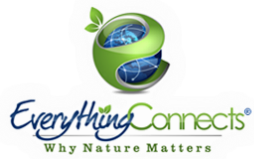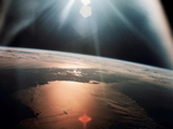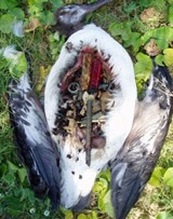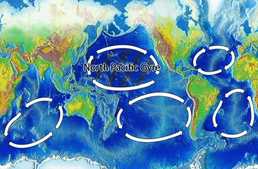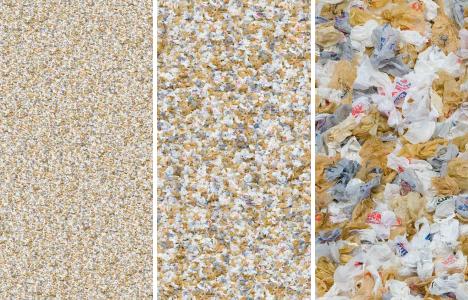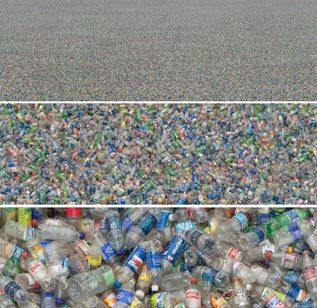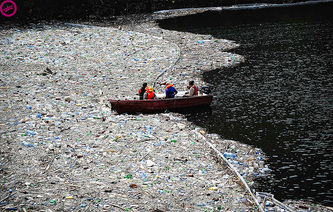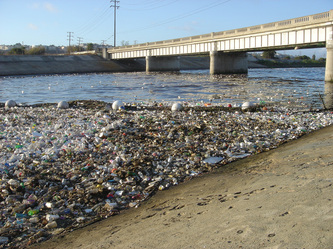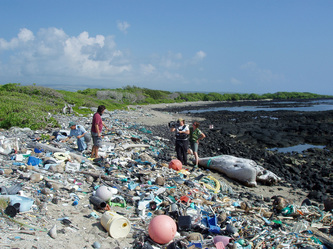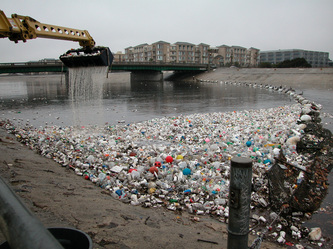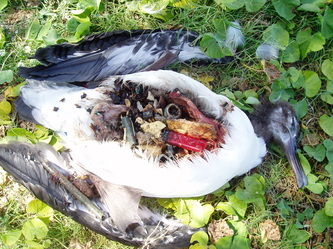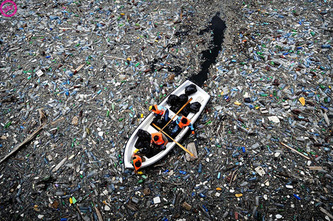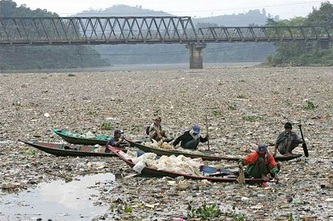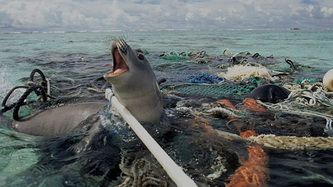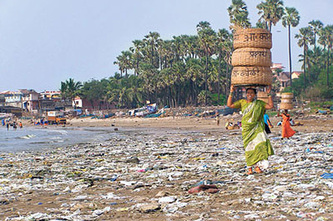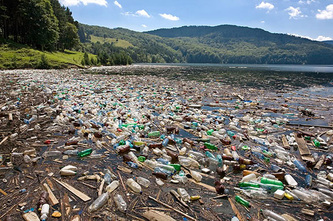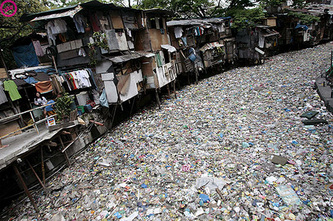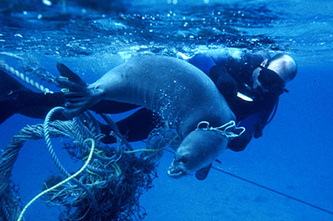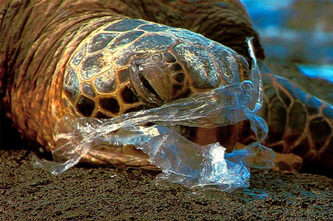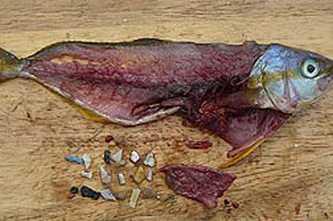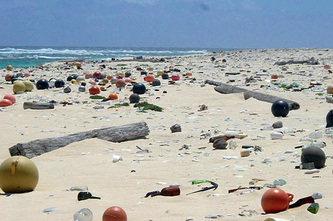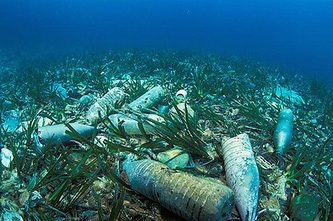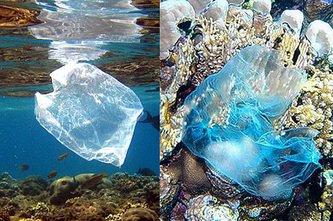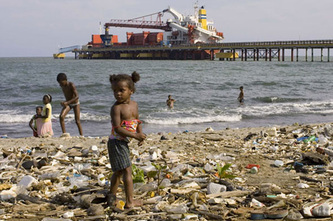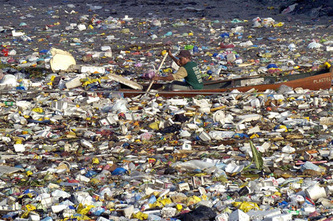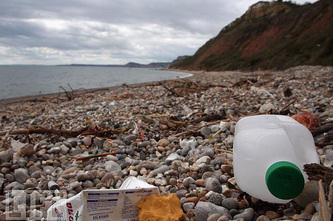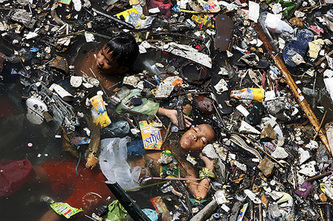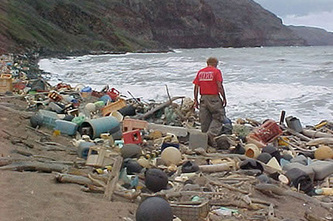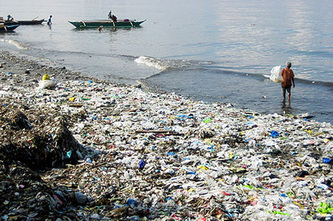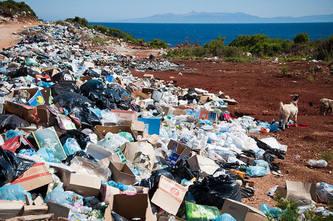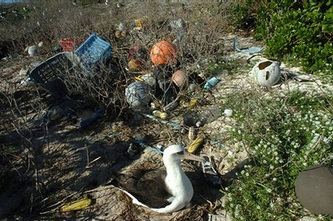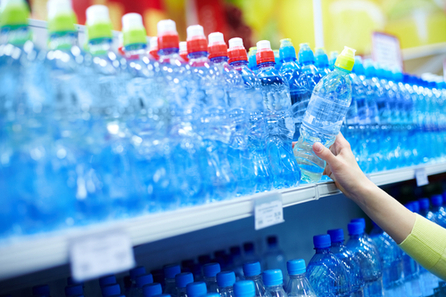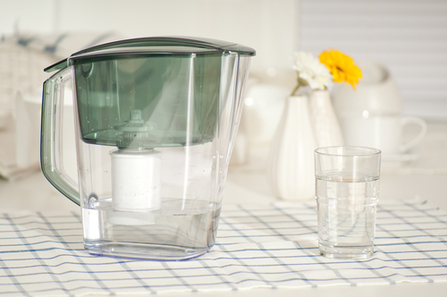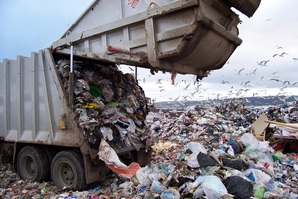|
|
The Drive Behind Mission #1
|
|
The Great Pacific Garbage Patch
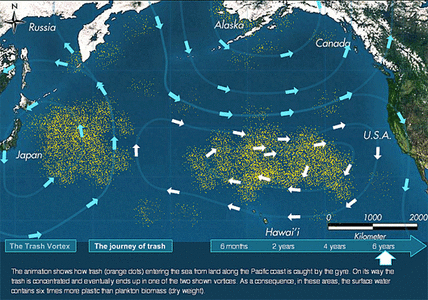 Click to view the "Eastern Garbage Patch" interactive map. Source: Greenpeace
Shaped by the rotating ocean currents and trade winds of the North Pacific gyre, the Great Pacific Garbage Patch consists of marine litter in the North Pacific Ocean. It is estimated to cover an area twice the size of the continental United States and contain around 100 million tons of marine debris, particularly plastics, all deriving from both land and ocean sources alike. Despite the immense size and density of this patch and contrary to common belief, it is not visible from satellite imagery since the particles that comprise the patch are mostly suspended in the upper water column just below the surface, hidden from the naked eye and satellite imagery. This garbage patch is formed primarily of plastic pollution gathered in ocean currents and trade winds. Every cubic meter of ocean in the Great Pacific Garbage Patch has about 100 times more plastic than it did in the 1970s. Water samples taken 40 years ago that contained little or no plastic are now polluted with billions of tiny pieces of confetti-like trash, known as “plastic soup.” Since the ocean is downhill to everything, any plastic you see lying around in your community or environment will eventually find its way into a storm drain, stream or river, which ultimately leads to the ocean - the Arctic being no exception (view study). Although plastic can eventually disintegrate into smaller pieces down to the molecular level, it remains intact as a polymer and attracts persistent organic pollutants, dioxins, and DDE on top of already containing toxic chemicals, such as PBA's, styrene, and flame retardants, which can leach out and cause endocrine disruption. In the ocean, plastics act like sponges as they attract hydrophobic toxic substances. Every bit of plastic ever made still exists, with the exception of the small amount that is actually recycled or incinerated, which can spew toxic chemicals into the air we breathe. According to the EPA, only 8% of the total plastic waste generated in 2010 was recovered for recycling. Surely, we can do better. How Plastic Bottles Are Bad For Your Health
There are now 46,000 pieces of plastic per square kilometer of the world's oceans, killing a million seabirds and 100,000 marine mammals each year. Learn more.
Marine Debris and Plastic Pollution Threaten Environmental Health
"And Man created the plastic bag and the tin and aluminum can and the cellophane wrapper and the paper plate, and this was good because Man could then take his automobile and buy all his food in one place and He could save that which was good to eat in the refrigerator and throw away that which had no further use. And soon the earth was covered with plastic bags and aluminum cans and paper plates and disposable bottles and there was nowhere to sit down or walk, and Man shook his head and cried: "Look at this Godawful mess." ~ Art Buchwald |
Navigation
Quick Facts about Plastic Pollution
(Sources: EPA, National Geographic, Readers Digest, Sierra Club, About.com, Earth 911)
| |||||||||||
China will save 37 million barrels of oil each year due to their ban on plastic bags. Learn more.
What
Can
We
Do
?
Can
We
Do
?
Whether intentional or not, our purchase of plastics, lack of proper recycling, or disharmonizing method of trashing our plastic leads to environmental, health and wildlife catastrophes worldwide.
|
|
The North Pacific Subtropical Gyre may be the largest, but it isn't alone.
|
Depicts 60,000 plastic bags, the number used in the U.S. every five seconds. Courtesy of Chris Jordan.
Depicts two million plastic beverage bottles, the number used in the U.S. every five minutes. Courtesy of Chris Jordan
|
Plastic bags are either restricted or completely banned in over a quarter of the world's countries, including China, Ireland, Australia, Bangladesh, Belgium, Italy, Ireland, Ethiopia, the Republic of Congo, Rwanda, South Africa and Hong Kong. Learn more.
. . . The Great Plastic Tide . . .
According to India Supreme Court Justices, plastic bags are a bigger threat to India's future than nuclear weapons. Learn more.
PVC Plastic
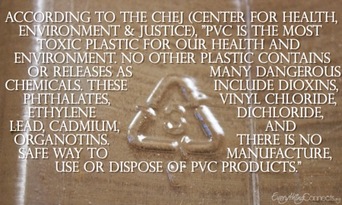
PVC plastic, known as polyvinyl chloride, is the most hazardous of all plastics at all stages of its life from its production in the factory to its use in products, our schools, hospitals, homes and offices to its disposal to our landfills, incineration or environmental waste. PVC has a horrific list of poisonous ingredients, including chlorine. In fact, PVC is the only plastic to contain chlorine. PVC also contains ethylene dichloride, mercury, dioxins, lead and vinyl chloride monomer. The only reason PVC is still in production today is because of its durability and low cost. PVC comes in many shapes and sizes from waterproof raincoats and boots, garden furniture, food containers and wrapping, fake leather shoes and purses to vinyl siding, windows and pipes. It is even around our kids in their toys and clothes. PVC production releases tons of toxic pollutants into the environment, including dioxins, which are a group of noxious chemicals that persist in the environment, travel great distances, build up in the food chain, harm the immune and reproductive system and cause cancer. The best action to take with PVC is to mail the plastic back to the company that sold it to you telling them it's toxic, un-recyclable and harmful and call customer service to tell them you’re not purchasing their products as long as it’s packaged or fused with the most toxic plastic on the planet. Recycling won’t do much justice since it only spreads the toxins, so trying to avoid it in the first place is your best bet. In the event of a fire, vinyl roofing and siding of homes made from PVC can literally kill with the toxic fumes created by burning PVC - before the fire even reaches a person. You can tell PVC by its distinct smell, such as the smell of a new car, a shoe section in a store or a new shower curtain and by the #3 recycling symbol, as illustrated above. Learn more.
"The amount of plastic pollution in the ocean is expanding at a catastrophic rate, but there are similar concentrations of plastic in the desert, in every community around the world, in our homes and in us." ~Plastic Pollution Coalition
Bottled Water vs. Filtered Water
|
The FDA federal regulations that govern the quality of bottled water only apply if it is transported across state lines, and only require it to be "as good as" tap water, not better. Bottled water is subject to far less stringent safety tests than tap water, is only required to undergo monthly testing and is much more likely to be contaminated or become a source of infection that tap water, whereas tap water is checked rigorously on a daily basis. 60-70% of bottled water companies bottle and sell the water in the same state to avoid Federal purity standards, thus avoiding complying with basic health standards, such as those that apply to municipally treated tap water! BPA in plastics and aluminum cans have been linked to heart and kidney disease and according to the Environmental Working Group, "The bottled water industry promotes an image of purity, but comprehensive testing by the Environmental Working Group (EWG) reveals a surprising array of chemical contaminants in every bottled water brand analyzed, including toxic byproducts of chlorination in Walmart’s Sam’s Choice and Giant Supermarket's Acadia brands, at levels no different than routinely found in tap water." There are no assurances or requirements that bottled water be any safer or better than tap water. The U.S. FDA says, "Companies that promote bottled water as being safer than tap water are defrauding the American public." Learn more.
|
According to Water Filter Comparisons, "Switching from bottled water to home water filtration is one of the fastest, easiest and most impactful steps to live healthy, save money and protect the planet. Home water purification is by far the most economical, most convenient and most effective way of producing high quality, healthy water. The facts are clear: Home water filtration offers better quality water than bottled water. Home water filtration is 1/10th the cost of bottled. Home water filtration is far more convenient, offering “Pure water on tap." Home water filtration is virtually pollution free. Filtering out the chlorine, lead and other contaminants with a quality home water filtration system, at the point of use, just prior to consumption, is the best way to know for sure about the quality of your drinking water. It’s also the most economical and the most environmentally responsible. It’s the right choice."
|
"Plastic creates toxic pollution at every stage of its existence: manufacture, use, and disposal. Plastic is a material that the Earth cannot digest. Every bit of plastic that has ever been created still exists, including the small amount that has been incinerated and has become toxic particulate matter." ~Plastic Pollution Coalition
Cutting open the stomachs of 67 northern dead fulmars, a type of seabird, scientists discovered that nearly 93% of the birds had plastic in their stomachs, with each bird containing an average of nearly 37 pieces of plastic, and with one bird having 454 pieces in its stomach. 96% of the plastic came from everyday consumer objects, such as rope, fishing lines, Styrofoam, bottle caps and candy wrappers. Learn more.
"From garbage crises in Greece and China to worldwide shortages of grain, meat and oil, our current consumption patterns are on a collision course with the Earth’s geological limits. The overriding challenge for our generation is to build a new economy — one that is powered largely by renewable sources of energy, that has a much more diversified transport system, and that reuses and recycles everything. We have the technology to build this new economy, an economy that will allow us to sustain economic progress. Can we build it fast enough to avoid a breakdown of social systems?" ~Lester R. Brown, Earth Policy Institute |
Throw Out the Throw Away Economy
As the economy drags on, people everywhere are re-embracing frugality. They hold onto their cars and materials a little longer, are buying less stuff, seeking used products and learning how to save money while satisfying their needs. But despite our best efforts, what's missing from the resourcefulness are products designed to last and not simply tossed away - almost instantaneously after one use. The end of World War II was a tough period. We were strained economically and mentally. We needed a rebound, something to help create jobs and sustain economic growth. Little did we know that this "rebound" was on a head-on collision with Earth's geological limits and fragile ecosystems. Nevertheless, we continued to replace our methods of utilizing cloth towels or napkins with disposable table napkins and refillable beverage containers for throwaway ones. Even the shopping bags that were continually carried around became part of the garbage flow. This is wasteful, unsustainable, and costly to society and the environment. Consequences of our throwaway society can be seen all around us in polluted environments, degraded lands, destroyed forests, filled landfills, and the rise of toxic electronics dumps around the world. The selling hand of throwaways was their convenience. The same convenience that is depleting our oil used to manufacture and transport throwaways, filling up our landfills, littering our environment, poisoning our health, killing millions of wildlife and costing our government, health and world a great price in hauling our garbage from cities to further and further away locations since nearby city landfills are becoming overflowed. An example of this is New York, which in March 2001, was one of the first major cities to exhaust its locally available landfills. In 2003, New York produced 12,000 tons of garbage each day and each tractor trailer carried about 20 tons with some 600 rigs being used to transport this garbage daily. These tractor trailers pollute the air, impede traffic and raise carbon emissions. These rigs would have to travel to Pennsylvania, New Jersey or even Virginia and some of these sites would be as far as 300 miles away. Today, according to GrowNYC, New York City still has no landfills or incinerators, but residents continue to produce 12,000 tons of waste every day and currently recycle only about 17% of their total waste with non-recyclable waste being sent to landfills in states like Pennsylvania, Ohio and Virginia. Learn more.
|
|
|
|
"The longevity of plastic is estimated to be hundreds to thousands of years, but is likely to be far longer in deep sea and non-surface polar environments. Plastic debris poses considerable threat by choking and starving wildlife, distributing non-native and potentially harmful organisms, absorbing toxic chemicals and degrading to micro-plastics that may subsequently be ingested." ~The Royal Society |
A humorous, but insightful quote, from a national radio personality went:
"Throughout the years man has come up with many ways to measure things. Noah used cubits to measure the Arc. We use carats to measure gemstones. We use lbs. to measure our weight. We use inches, feet and yards to measure distance. And to measure the intelligence of consumers... they put water in plastic bottles... to see who would buy it." |
- City tap water can have no confirmed E.coli or fecal coliform bacteria. FDA bottled water rules include no such prohibition (a certain amount of any type of coliform bacteria is allowed in bottled water).
- City tap water, from surface water, must be filtered and disinfected. In contrast, there are no federal filtration or disinfection requirements for bottled water.
- Most cities using surface water have had to test for Cryptosporidium or Giardia, two common water pathogens, that can cause diarrhea and other intestinal problems, yet bottled water companies do not have to do this.
- City tap water must meet standards for certain important toxic or cancer-causing chemicals, such as phthalate (a chemical that can leach from plastic, including plastic bottles); some in the industry persuaded FDA to exempt bottled water from the regulations regarding these chemicals.
- City water systems must issue annual "right to know" reports, telling consumers what is in their water. Bottlers successfully killed a "right to know" requirement for bottled water.
Dig Deeper into the Great Pacific Garbage Patch
Each year, plastic pollution kills an estimated 100,000 sea turtles and marine mammals and 1,000,000 sea creatures each year. This 60 Minutes’ story ‘Seas of Shame’ from 2008 explores how the vast oceans of the world are literally choking with the rubbish we throw away, and the havoc our waste causes wildlife.
|
Last Revised: 11/20/13
Commenting Rules |
